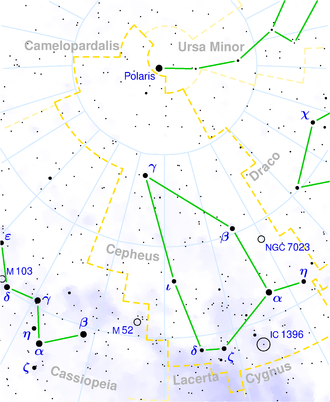NGC 6951
| Galaxy NGC 6951 / NGC 6952 |
|
|---|---|

|
|
| Photo from the Hubble Space Telescope | |
| AladinLite | |
| Constellation | Cepheus |
|
Position equinox : J2000.0 , epoch : J2000.0 |
|
| Right ascension | 20 h 37 m 14.41 s |
| declination | + 66 ° 06 ′ 19.7 ″ |
| Appearance | |
| Morphological type | SAB (rs) bc / LINER / Sy2 |
| Brightness (visual) | 11.0 mag |
| Brightness (B-band) | 11.8 mag |
| Angular expansion | 3.9 ′ × 3.2 ′ |
| Position angle | 170 ° |
| Surface brightness | 13.6 mag / arcmin² |
| Physical data | |
| Redshift | 0.004750 ± 0.000005 |
| Radial velocity | 1424 ± 1 km / s |
|
Stroke distance v rad / H 0 |
(73 ± 5) · 10 6 ly (22.5 ± 1.6) Mpc |
| history | |
| discovery | Jérôme Eugène Coggia Lewis A. Swift |
| Discovery date | 1877 September 14, 1885 |
| Catalog names | |
| NGC 6951/6952 • UGC 11604 • PGC 65086 • CGCG 325-003 • MCG + 11-25-002 • IRAS 20366 + 6555 • 2MASX J20371407 + 6606203 • 2XMM J203714.0 + 660619 | |
NGC 6951 = NGC 6952 is a bar-spiral galaxy with an active nucleus of the Hubble type SBb-c in the constellation Cepheus in the northern sky . It is about 73 million light years away from the Milky Way and has a diameter of about 70,000 light years.
discovery
The galaxy NGC 6951 was discovered on September 14, 1885 by the American astronomer Lewis A. Swift . In 1877, the French astronomer Jérôme Eugène Coggia was already observing the same galaxy. The double observation was not recognized and so it was given the number NGC 6952 .
Web links
Commons : NGC 6951 - collection of images, videos, and audio files
